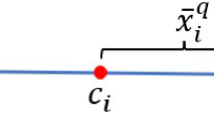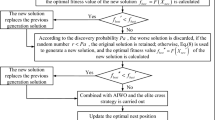Abstract
The core objective of controlling topology, conserving energy and extending the life cycle in sensor networks is highly indispensable for maximizing its lifetime. Meta-heuristic optimization algorithms are found to be optimal in facilitating the process of cluster head election and clustering. An Improved Artificial Bee Colony Optimization-based Clustering Technique (IABCOCT) is propounded by deriving the merits of Grenade Explosion and Cauchy operator for ensuring optimal clustering process and election of cluster heads. The potential of Grenade Explosion and Cauchy operator are embedded in the Onlooker Bee and scout bee phase for phenomenal improvement in the degree of exploitation and exploration of searching that aids in the optimal election of cluster heads. This incorporation of Grenade Explosion and Cauchy operator in the clustering process maximizes the rate of cluster head election for reducing energy consumption in sensor nodes that enhances lifetime of the network. The potential of IABCOCT is studied through simulation experiments and its performance is investigated against Enhanced Particle Swarm Optimization Technique (EPSOCT), Hierarchical Clustering-based Cluster Head Election (HCCHE) and Competitive Clustering Technique (CCT). The simulation results of IABCOCT prove that the mortality rate of sensor nodes is minimized for enhancing network lifetime. The results deduce that the relative energy, dropping ratio, Mean energy consumption and Network Routing Overhead is better than EPSOCT, HCCHE and CCT under the impact of varying number of rounds.













Similar content being viewed by others
References
Abdulla, A. E., Nishiyama, H., & Kato, N. (2012). Extending the lifetime of wireless sensor networks: A hybrid routing algorithm. Computer Communications,35(9), 1056–1063.
Liu, X., & He, D. (2014). Ant colony optimization with greedy migration mechanism for node deployment in wireless sensor networks. Journal of Network and Computer Applications,39(1), 310–318.
Kuila, P., & Jana, P. K. (2014). A novel differential evolution based clustering algorithm for wireless sensor networks. Applied Soft Computing,25(2), 414–425.
Keskin, M. E., Altınel, İ. K., Aras, N., & Ersoy, C. (2014). Wireless sensor network lifetime maximization by optimal sensor deployment, activity scheduling, data routing and sink mobility. Ad Hoc Networks,17(1), 18–36.
Amgoth, T., & Jana, P. K. (2015). Energy-aware routing algorithm for wireless sensor networks. Computers & Electrical Engineering,41(1), 357–367.
Tarng, W. (2012). A cluster allocation and routing algorithm based on node density for extending the lifetime of wireless sensor networks. International Journal of Computer Science and Information Technology,4(1), 51–62.
Meghanathan, N. (2014). Stability-based and energy-efficient distributed data gathering algorithms for wireless mobile sensor networks. Ad Hoc Networks,19, 111–131.
Thilagavathi, S., & Gnanasambandan Geetha, B. (2015). Energy aware swarm optimization with intercluster search for wireless sensor network. The Scientific World Journal,2015, 1–8.
Zhang, L., Tian, F., Kadri, C., Pei, G., Li, H., & Pan, L. (2011). Gases concentration estimation using heuristics and bio-inspired optimization models for experimental chemical electronic nose. Sensors and Actuators B: Chemical,160(1), 760–770.
Manjeshwar, A., & Agrawal, D. (2015). TEEN: A routing protocol for enhanced efficiency in wireless sensor networks. In Proceedings 15th international parallel and distributed processing symposium. IPDPS 2001.
Gupta, V., & Sharma, S. K. (2014). Cluster head selection using modified ACO. Advances in Intelligent Systems and Computing,1(1), 11–20.
Kumar, S. (2016). Optimization of ant based cluster head election algorithm in wireless sensor networks. International Journal of Computer Applications,144(2), 5–9.
Punj, R., & Kumar, R. (2017). CHS-GA: An approach for cluster head selection using genetic algorithm for WBANs. Online Engineering & Internet of Things,2(1), 28–35.
Rao, P. C., Jana, P. K., & Banka, H. (2016). A particle swarm optimization based energy efficient cluster head selection algorithm for wireless sensor networks. Wireless Networks,23(7), 2005–2020.
Karimi, M., Naji, H. R., & Golestani, S. (2012). Optimizing cluster-head selection in wireless sensor networks using genetic algorithm and harmony search algorithm. In 20th Iranian conference on electrical engineering (ICEE 2012) (vol. 2, no. 1, pp. 28–35).
Vijayalakshmi, K., & Anandan, P. (2018). A multi objective Tabu particle swarm optimization for effective cluster head selection in WSN. Cluster Computing,2(1), 34–43.
Vimalarani, C., Subramanian, R., & Sivanandam, S. N. (2016). An enhanced PSO-based clustering energy optimization algorithm for wireless sensor network. The Scientific World Journal,2016(1), 1–11.
Park, G. Y., Kim, H., Jeong, H. W., & Youn, H. Y. (2013). A novel cluster head selection method based on k-means algorithm for energy efficient wireless sensor network. In 2013 27th international conference on advanced information networking and applications workshops (vol. 2, no. 1, pp. 34–45).
Thiriveni, G. V., & Ramakrishnan, M. (2016). Distributed clustering based energy efficient routing algorithm for heterogeneous wireless sensor networks. Indian Journal of Science and Technology,9(3), 34–43.
Heinzelman, W., Chandrakasan, A., & Balakrishnan, H. (2002). An application-specific protocol architecture for wireless microsensor networks. IEEE Transactions on Wireless Communications,1(4), 660–670.
Hoang, D. C., Yadav, P., Kumar, R., & Panda, S. K. (2010). A robust harmony search algorithm based clustering protocol for wireless sensor networks. In 2010 IEEE international conference on communications workshops (vol. 1, no. 1, pp. 23–31).
Zhang, C., Zheng, J., & Zhou, Y. (2013). Two improved artificial bee colony algorithms inspired by grenade explosion method. Communications in Computer and Information Science,1(1), 100–105.
Zhang, C., Zheng, J., & Zhou, Y. (2015). Two modified artificial bee colony algorithms inspired by grenade explosion method. Neurocomputing,151, 1198–1207.
Zheng, J., Zhang, C., & Zhou, Y. (2015). Artificial bee colony algorithm combined with grenade explosion method and cauchy operator for global optimization. Mathematical Problems in Engineering,2015, 1–14.
Zhang, S., & Liu, S. (2015). A novel artificial bee colony algorithm for function optimization. Mathematical Problems in Engineering,2015, 1–10.
Author information
Authors and Affiliations
Corresponding author
Additional information
Publisher's Note
Springer Nature remains neutral with regard to jurisdictional claims in published maps and institutional affiliations.
S. Famila—Research Scholar.
Rights and permissions
About this article
Cite this article
Famila, S., Jawahar, A. Improved Artificial Bee Colony Optimization-Based Clustering Technique for WSNs. Wireless Pers Commun 110, 2195–2212 (2020). https://doi.org/10.1007/s11277-019-06837-6
Published:
Issue Date:
DOI: https://doi.org/10.1007/s11277-019-06837-6




